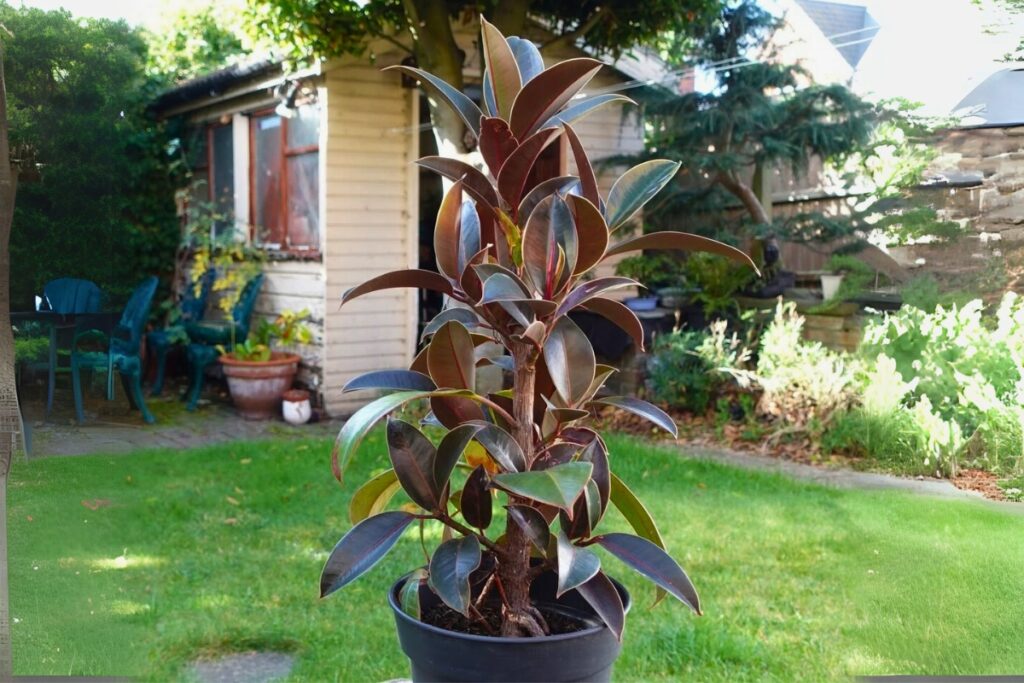If you’ve ever wondered why some rubber plants look like miniature trees while others resemble lush, leafy bushes, it all comes down to proper care techniques. You’ll find that transforming a leggy rubber plant into a full, bushy specimen isn’t just about regular watering and sunlight. The secret lies in understanding the plant’s growth patterns and knowing exactly when and where to make strategic cuts. Let’s explore how you can shape your rubber plant into the showstopping houseplant you’ve always wanted.

Contents
Understanding Rubber Plant Growth Patterns
Rubber plants (Ficus elastica) naturally grow in a vertical pattern, producing one main stem with leaves emerging along the sides. In their native habitat, they can grow up to 100 feet tall, but as houseplants, they typically reach heights of 6-10 feet. The growth pattern involves new leaves emerging from the top of the plant, while older leaves remain on the lower portions of the stem.
These plants exhibit apical dominance, meaning the topmost growth point (apex) produces hormones that suppress the development of side branches. Without intervention, rubber plants will continue growing straight up, becoming tall and potentially leggy. The spacing between leaves (internodes) can become longer when the plant isn’t receiving ideal light, resulting in a sparse appearance rather than the desired bushy form.

Optimal Light and Environmental Conditions
Rubber plants thrive in bright, indirect sunlight, which is essential for developing dense, bushy growth. Placing them near east or north-facing windows provides ideal light conditions without risking leaf burn from direct sun exposure. If natural light is limited, supplemental growing lights can help maintain healthy growth and prevent leggy stems.
Temperature and humidity play vital roles in promoting bushy growth. Rubber plants prefer temperatures between 60-80°F (15-27°C) and humidity levels around 40-60%. Using a humidity tray or running a humidifier helps maintain appropriate moisture levels, especially in dry indoor environments. Avoid placing the plant near air conditioning vents or heating units, as sudden temperature fluctuations can stress the plant and inhibit healthy growth.
Strategic Pruning Techniques for Fuller Growth
Strategic pruning techniques play a crucial role in encouraging rubber plants to grow fuller and bushier. The key is to cut just above a leaf node, which promotes branching and new growth from that point. For best results, pruning should be done during the active growing season, typically spring or early summer, when the plant can readily produce new shoots.
Making precise cuts at a 45-degree angle helps prevent water accumulation and disease while stimulating the plant to develop multiple new branches. Once the main stem is cut, the rubber plant typically responds by producing two or more new shoots below the cut point. This branching effect can be repeated on new growth to create an increasingly dense, well-shaped plant. Remove any dead, damaged, or crossing branches to maintain the plant’s health and desired shape while promoting bushier growth.
Fertilization and Soil Requirements
Rubber plants thrive in well-draining, nutrient-rich soil with a pH level between 6.0 and 7.0. A quality potting mix containing peat moss, perlite, and regular potting soil provides the ideal growing medium. This combination guarantees proper drainage while retaining enough moisture for healthy growth.
Regular fertilization during the growing season (spring and summer) is essential for promoting bushy growth. Apply a balanced, water-soluble fertilizer (10-10-10 or 20-20-20) every 2-3 weeks. During fall and winter, reduce fertilization to once every 6-8 weeks, as the plant’s growth naturally slows down. Over-fertilization can lead to leaf burn and leggy growth, so it’s important to follow the recommended dosage on the product label.
Training and Supporting Your Rubber Plant
Training and pruning rubber plants requires consistent attention to shape growth and establish a strong structure. Staking young plants with bamboo poles or plant supports helps them grow straight and provides stability as they develop. For bushier growth, pinch off the growing tips of branches, which encourages the plant to produce multiple new shoots below the pinch point.
Regular rotation of the plant guarantees even growth on all sides, preventing it from becoming leggy or growing primarily toward light sources. Supporting heavy branches with soft plant ties or natural twine prevents breakage and allows for directional training. When tying branches, leave enough room for growth and avoid creating tight binds that can damage the plant tissue.
Common Issues Affecting Plant Fullness
Poor lighting conditions and incorrect pruning practices are two of the most common issues affecting rubber plant fullness. When rubber plants receive insufficient light, they tend to become leggy and sparse, with elongated stems and fewer leaves. Similarly, if the plant is not pruned regularly or is pruned incorrectly, it may grow tall and thin rather than developing a full, bushy appearance.
Nutritional deficiencies and improper watering can also impact a rubber plant’s fullness. Without adequate nutrients, particularly nitrogen, the plant may produce smaller leaves and fewer branches. Overwatering or underwatering can cause leaf drop and stunted growth, leading to a less full appearance. Additionally, environmental stress factors such as dramatic temperature fluctuations or low humidity can cause the plant to lose leaves and become sparse.
